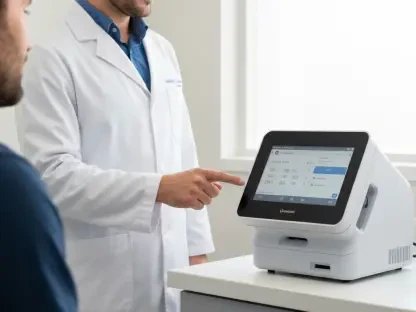In the expansive rural areas of New Mexico, accessing healthcare has remained a significant challenge due to the region’s geographical isolation and often limited infrastructure. Addressing this critical issue with innovative solutions is essential. In recent years, an initiative championed by Deirdre Caparoso from The University of New Mexico Health Sciences Library, in partnership with the New Mexico State Library, has unveiled a promising development: the deployment of telehealth booths. These booths mark a significant stride forward in ensuring that rural communities have direct access to healthcare services. By harnessing telehealth in public libraries, communities traditionally deprived of immediate healthcare access can now connect with providers virtually, promising a reduction in the barriers posed by distance and technology.
Transformative Role of Telehealth Booths
Leveraging Technology for Rural Accessibility
Telehealth booths, small soundproof rooms equipped with internet connectivity, are designed to facilitate direct interactions between individuals and healthcare providers. These booths provide convenience and confidentiality, essential for discussing private health matters securely. Funded by the U.S. Department of Agriculture’s Telemedicine & Distance Learning Grant program, these booths have begun to make their presence felt in selected libraries across New Mexico. This strategic integration offers rural residents an alternative to lengthy travels, thus optimizing healthcare access and ensuring timeliness. Libraries, an underutilized community resource, play a crucial role by serving as hubs for these technological interventions. By enabling patrons to use either personal devices or equipment provided, the booths are adaptable and responsive to diverse user needs.
Addressing Digital Inequities
Digital inequity is pervasive in many parts of New Mexico, where a lack of reliable high-speed internet hinders access to telehealth services. By positioning these booths within public libraries, the initiative capitalizes on the existing robust internet infrastructure inherent in these community spaces. Libraries thus extend their purpose beyond traditional knowledge dissemination to become pivotal points of technological access. With this, they empower communities by bridging the gap between healthcare accessibility and digital barriers. Libraries are now viewed as essential components of community health infrastructure, offering not just a physical space for resource access but also technical support that can transform healthcare engagement in isolated areas.
Enhancing Community Involvement and Access
Inclusivity and Accessibility
Inclusivity forms a core principle of the telehealth booth initiative, accounting for the diverse needs of New Mexico’s multigenerational families often seeking healthcare collaboratively. The booth’s design accommodates multiple users comfortably and includes wheelchair accessibility, ensuring equitable access for users of all abilities. This thoughtful inclusion highlights the project’s sensitivity to cultural dynamics within rural communities. Additionally, by providing a secure environment, the booths are particularly valuable for mental health and substance abuse consultations, where privacy is paramount. Many residents in rural New Mexico lack private spaces conducive to such sensitive discussions, and the library booths provide a welcoming refuge that respects individual privacy while facilitating vital healthcare communication.
Expanding Beyond Healthcare
Primarily designed to facilitate healthcare access, these telehealth booths have demonstrated versatility in supporting various community initiatives. Libraries are adapting these resources to meet local needs, showcasing applications beyond healthcare. For instance, the Mescalero Community Library utilizes its telehealth booth in its tribal language programs, tapping into the booth’s recording capabilities. Such adaptations illustrate the booth’s potential as a multifunctional community resource, fostering education and cultural preservation alongside healthcare. This ability to serve as a flexible tool makes the booths an integral part of community development and highlights libraries as dynamic community centers capable of addressing an array of local needs in innovative ways.
Future Prospects and Community Empowerment
Expanding Reach Across New Mexico
Looking ahead, plans are in motion to extend the installation of telehealth booths to additional rural areas by late fall and further into the coming years. This expansion aims to amplify the project’s reach and impact, ensuring more communities benefit from improved healthcare access. Training programs tailored for library staff are also underway, equipping them with the skills necessary to assist patrons in navigating telehealth services effectively. By building staff competency in this realm, libraries can enhance their role as facilitators of health literacy and digital engagement, thus progressively transforming into comprehensive community resource hubs. The ongoing strategic efforts underline the commitment to inclusivity and support the adaptation of these services by rural populations.
Libraries as Catalysts of Change
Initially created to enhance access to healthcare, telehealth booths have shown a remarkable ability to support a wide array of community-driven initiatives. These booths are finding a home in libraries, where they are reimagined to address specific local needs, thereby demonstrating their utility beyond medical applications. For example, the Mescalero Community Library is leveraging its telehealth booth to boost its tribal language programs by using the booth’s recording features. Such innovative uses underscore the booth’s versatility as a community asset that not only enhances healthcare accessibility but also promotes educational activities and cultural preservation. This adaptability makes telehealth booths a vital component in community development strategies, reinforcing the role of libraries as vibrant community hubs. They are equipped to tackle a variety of local challenges creatively and effectively, underscoring their significance in meeting diverse community needs in numerous innovative ways.









